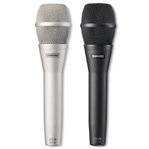Tips on Using Your Microphone
In last month's newsletter, we offered tips on choosing the right microphone. Now let's focus on how to use your mic correctly.1. Setting up your microphone stand and cable. Now that you've chosen your mic, we can move onto setting up the mic, stand, and cable (if the type of mic you chose is mounted on a stand). One of the first things to remember is to never force the stand to tighten or it will soon lose its capability to hold the mic. Make sure the stand is loose and then tighten each piece of the stand. Do this at the column of the stand, then where the column meets the arm, and finally the arm itself. Next, make sure one of the legs of the stand is positioned directly below the arm. This will make the stand more stable and prevent tipping. In order to save some time when you need to reposition the mic, run the cable from the wall or mic jack and leave the slack coiled up at the bottom of the stand. Then take the cord and wrap it around the vertical part once and around the boom arm once. This will look neat as well as allow you to move the stand easily if need be.
2. Positioning your microphone correctly. One great tip in mic placement is to position the mic away from the unwanted sound (if you're using a cardiod polar pattern). You want to separate the wanted source as much as possible from the unwanted source to get the best signal-to-noise ratio. Secondly, keep the microphone as far away as possible from the sound source, such as a mixer. Microphones that are positioned too closely will cause what is called the "proximity effect," or an increase in the bass, which may cause an unwanted “muddy” or unnatural sound. Bottom line? If you're not getting the sound you desire, try repositioning the microphone first.
3. Avoiding feedback. Here are a couple quick tips on reducing your risk of the high-pitched squeal called feedback. Never point a microphone in the direction of a speaker. Never put a sensitive mic too close to headphones. Keep in mind that if the volume is too high coming out of the mixer or speakers, feedback will also occur.

4. Storing your microphone. After use, microphones should receive special attention. Anytime you turn on or off a condenser mic, or disconnect any microphones, be sure to mute the speakers and turn the volumes all the way down on the channels that the mics are plugged into. This will avoid bangs, pops, and even damage to your microphones and speakers. When storing your mics, make sure to keep them in a warm and dry case, keeping them free from moisture and dust. This will prolong the life of your microphones. And last but not least always handle your microphones with care!



